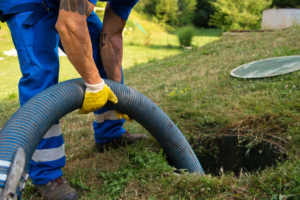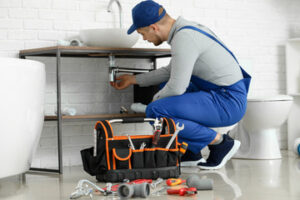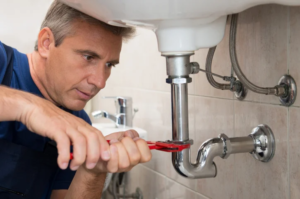From your toilets, showers, bathtub and sinks, wastewater runs into a main sewer line that slopes to your septic tank.
Solid wastes sink to the bottom of your septic tank, becoming a layer known as sludge. Fats, oils and greases float on top of the wastewater, becoming a layer called scum. Contact Septic Tank Armadale now!

A septic tank is an underground watertight container made of fiber glass, plastic or concrete. It is used in homes and cottages that are not connected to a municipal sewer system.
Every time you flush a toilet or wash clothes, wastewater enters your home through the sewer line and flows into your septic tank. From there it separates into three general components — solids or “sludge”, floatables (such as fats and oils) and a zone of relatively clear water. Microorganisms in your septic tank perform the first treatment by breaking down these components into a liquid form. The liquid then flows to the drain field area.
All septic tanks have an inlet baffle and an outlet baffle. The inlet baffle keeps sludge from entering the absorption field, which could clog and decrease the efficiency of your septic system. The outlet baffle prevents sludge from leaving the tank, which could clog the pipes leading to your absorption field.
In the drain field area, an aerobic bacteria system breaks down any remaining contaminants in the wastewater. This process lowers concentrations of organic matter, suspended solids, pathogens and nutrients like phosphorus and nitrogen. The treated wastewater then percolates through a layer of gravel and into the native soil. From there, it drains into a stream, river or lake.
If you have a septic tank, it’s important to keep an eye on your septic system and make sure it is working correctly. If you notice a foul smell, slow drainage or backflow from your sinks or toilets, it may be time to have your septic tank inspected. Also, be sure to use septic-safe products, such as biodegradable toilet paper and cleaning products. And don’t build anything over the drainfield, which can cause it to compact and block the flow of wastewater into the soil. This can cause sewage to back up into your home and create a health hazard. It’s also a good idea to have your septic tank pumped every one to four weeks. Having it pumped regularly helps keep your septic system healthy and reduces the need for repairs.
Installation
If you have recently purchased a property with an off-mains septic tank, or are looking to install one for your new home, it is crucial to work with a reputable installation company. This will ensure that your septic system is properly placed and correctly installed, and complies with all local regulations. Wrong installation is the root cause of most off-mains septic tank problems, and can lead to expensive repair bills down the road.
During the planning stage, your installation team will work with you to determine the best type of septic system for your household and land, as well as how large the tank should be. They will also consider factors such as your soil type, the slope of your land, and any nearby trees that could affect the drain field. They will also make sure to place the tank within a safe distance from your house and any other buildings, and take into account how close it is to any bodies of water such as lakes and rivers.
Once the septic tank is in place, it must be filled with water and inspected to be sure that it is leak-free. Once the tank is tested and approved, it can be backfilled with sand, gravel, or concrete. It is recommended to follow the manufacturer’s instructions for backfilling, as each type of material may require different methods.
The next step is to install the pipes between the septic tank and your drainage field, which is commonly known as the leach field. It is important to ensure that the drainage field is sized appropriately, as too small a leach field can result in a clogged or overflowing drainfield. Too large a drainfield can cause the liquid sewage to seep into the surrounding groundwater, which is harmful to the environment.
Your septic system will have a vent that allows the gasses to escape, which is essential to the proper function of the system. If you notice any unusual odors in your home or yard, it could indicate that the ventilation pipe is clogged and allowing sewage to leak out of the tank.
Maintenance
The bacteria in your septic tank produce gases as they break down the waste. These gases must be released to prevent a build-up of pressure that could stop or reverse the flow of wastewater. The gases are released through a vent in the septic tank lid. This vent is usually shaped like a mushroom and can be fitted with a charcoal filter to reduce odors.
A septic system’s soil absorption field is a series of perforated pipes in gravel trenches that allow liquid waste to seep out into the ground. The wastewater is then further filtered by the soil and grass above it. When the solids in your septic tank are too dense, they can flow to the drainfield and clog it. Over time, the drainfield will fail and sewage will overflow to the ground surface, exposing humans and animals to disease-causing organisms.
To keep your septic system in good working order, have it regularly inspected by a licensed inspector. Inspectors look for a variety of issues, including pipe integrity and proper ventilation. They also check for leaking and clogging, which can be difficult to spot without an inside view of the septic tank.
Septic tanks are a large investment, and it’s important to maintain them properly to avoid costly repairs. Have your septic tank pumped regularly, and have your garbage disposal checked for a leaky pipe that could be sending food scraps to the septic tank. It’s best to have the septic tank pumped through the central manhole instead of through the baffle inspection ports, as pumping the tank directly through the baffles can damage them.
When you have your septic tank pumped, ask the pumper to help you locate the absorption field. Draw a diagram or map of the location and mark it with easy-to-reach landmarks such as steps, fence posts, and corner points of your home. Keep this sketch with your septic tank records. Plant only grass or shallow-rooted plants over the absorption field to protect it from deep roots that could pierce the pipes and cause failure.
Be wary of products that claim to speed up the breakdown process or add extra bacteria. These chemicals can upset the delicate balance of microorganisms in your septic tank, and they can clog up your entire system.
Repairs
Because septic systems are underground, they often go unnoticed until something goes wrong. A septic tank that is full of waste or a broken component can result in sewage backing up into drains or even entering the home. In the worst case scenario, a septic system that is not maintained can cause serious health issues for you and your family.
Septic tanks need to be pumped regularly. The amount of water you use and what you put down your drains can impact how often your septic system needs to be pumped. If your septic tank is not pumped, it can overflow and contaminate your soil with disease-causing bacteria.
If you notice that your septic tank is leaking, there could be a problem with the seal or lid. A professional can inspect your septic tank and determine the best way to repair it.
Your septic tank should have an outlet filter that helps keep solids from exiting the tank and clogging up your drain field. If your septic tank does not have an outlet filter or your current one is damaged, contact Hapchuk, Inc to have a new one installed.
Another sign that your septic tank is in need of repair is if it has strong odors coming from your drains and yard. These smelly odors are caused by a buildup of anaerobic bacteria that digests organic materials in your drains and toilets. If the smells are severe, it is likely that your septic tank has a clog and that the anaerobic bacteria are no longer working properly.
Your septic system should have a ventilation pipe that carries away septic system gases. These gases consist of carbon dioxide, methane and nitrous oxide. If the ventilation pipe is clogged, this can lead to a toxic buildup of these gases in your home and yard. The clogged vent should be cleaned by a professional.
A healthy septic system will also have a drainfield to further filter wastewater and septic system waste before it enters groundwater. The drainfield is a shallow area of uncovered soil near the septic tank that filters wastewater through rocks, dirt and sand to remove impurities naturally. When a septic tank fails to pump out regularly, the sludge and scum layers can grow so thick that they block the drainfield, causing it to fail.

